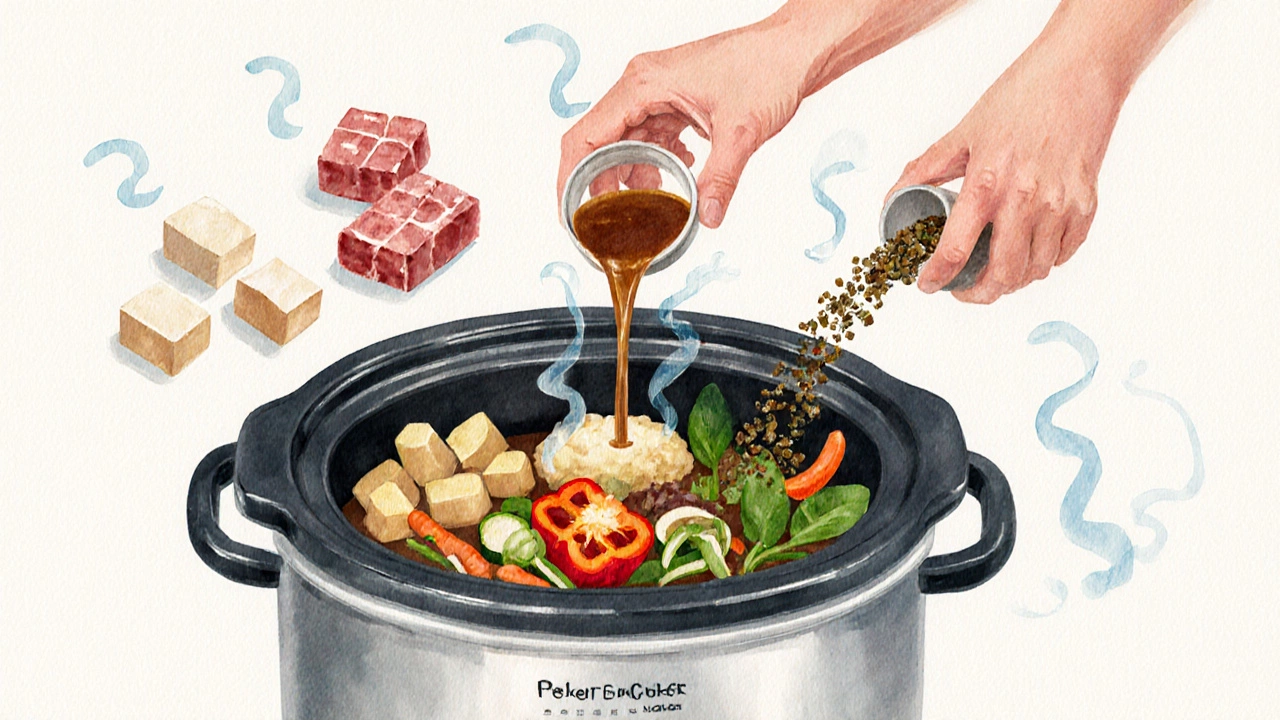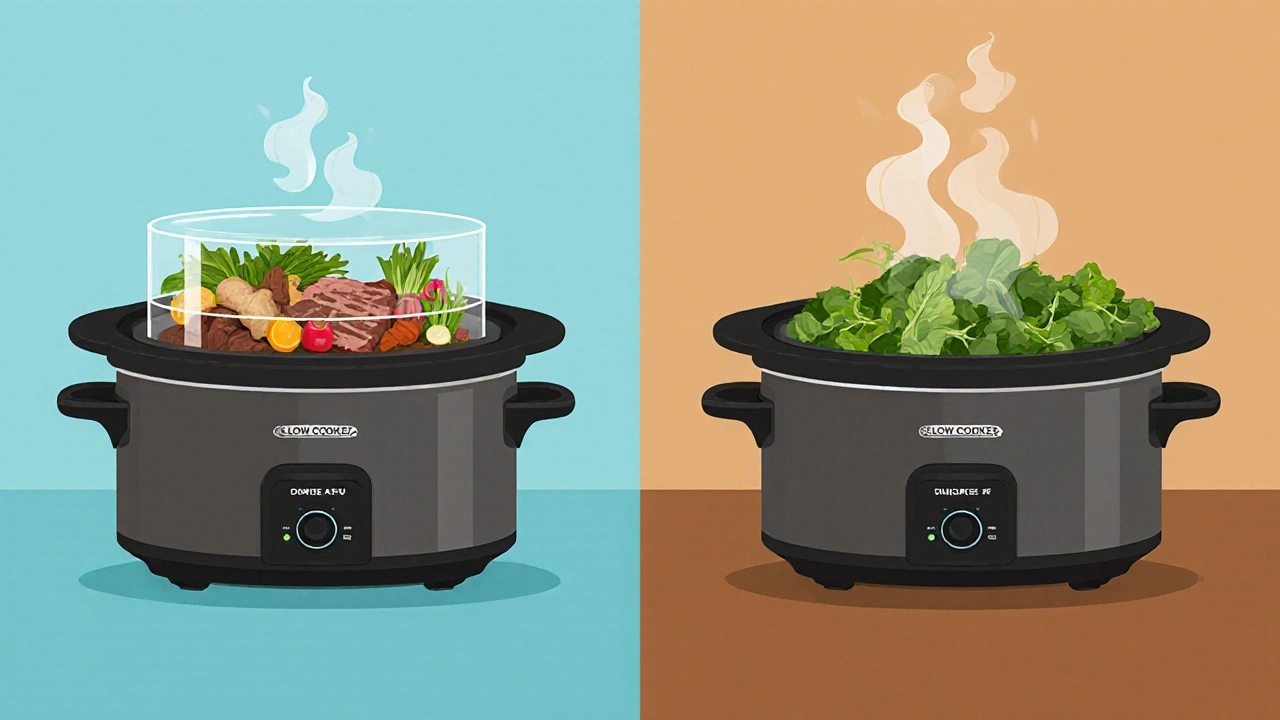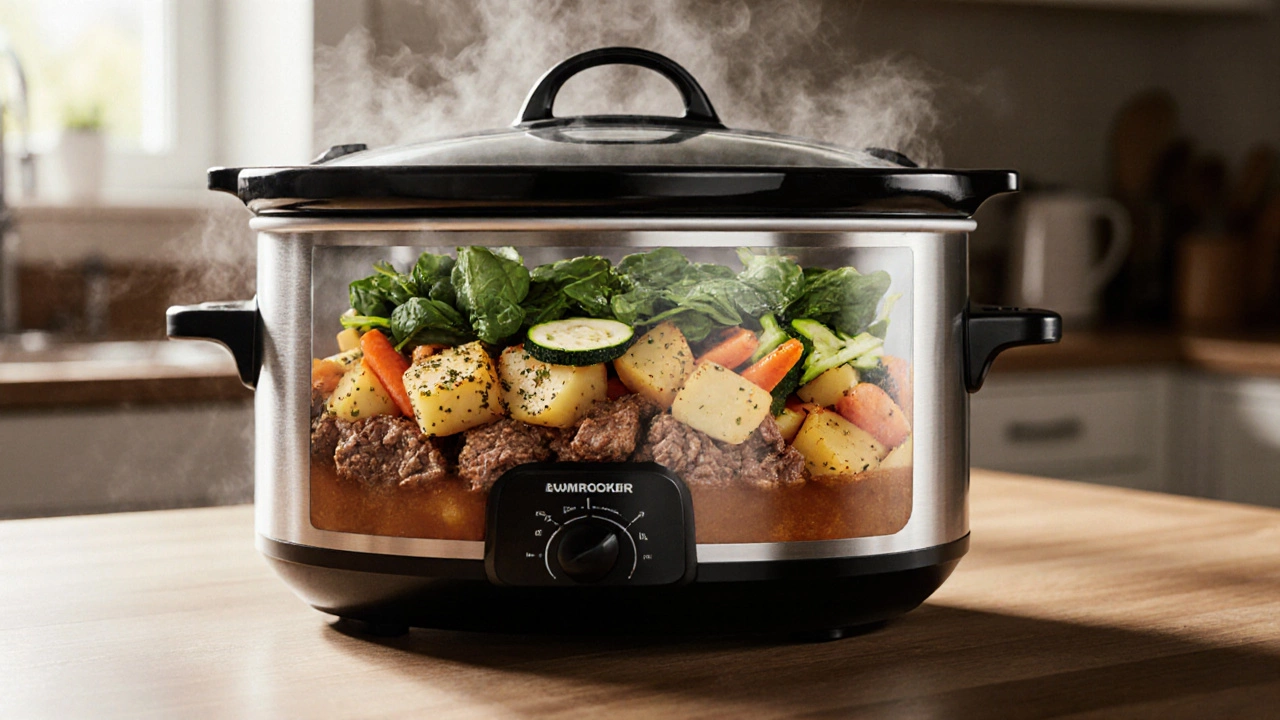When you drop ingredients into a Slow Cooker a countertop appliance that cooks food slowly at low temperatures, ideal for tenderizing tough cuts and melding flavors, the order you stack them can make or break the dish. Ever wondered why some stews turn mushy while others stay perfectly textured? The secret is usually the way you layer the food.
Why Layering Matters
Layering isn’t just about looking neat; it controls how heat, moisture, and flavor travel through the pot. The ingredients at the bottom sit in the hottest zone, while those on top experience gentler heat. This natural gradient lets you:
- Keep delicate veggies from over‑cooking.
- Ensure meat stays juicy by staying submerged in liquid.
- Allow sauces to thicken without scorching.
Think of it as a culinary assembly line where each step adds value.
Basic Principles of Layering
Before you start, keep these three rules in mind:
- Heavier, denser items go first. They need the most heat.
- Liquid should cover the bottom half of the pot. This prevents a dry burn.
- Delicate items belong on top. They only need steam, not direct simmer.
These principles work for almost any recipe, whether you’re making a beef stew or a vegan lentil curry.
Step‑by‑Step Guide to Perfect Layering
- Meat any protein such as beef, chicken, pork, or tofu or firm vegetables go in first. If you’re using a tough cut like chuck roast, slice it into uniform chunks so it cooks evenly.
- Add Starch potatoes, sweet potatoes, carrots, or rice. Starches absorb liquid and need the most time to soften.
- Pour in your Liquid broth, water, wine, or canned tomatoes. Aim for enough to cover the bottom half of the ingredients; you can always add more later.
- Scatter Seasonings salt, herbs, spices, and aromatics. Fresh herbs go on top; dried herbs can be mixed in with the liquid.
- Top it off with delicate Vegetables like bell peppers, zucchini, or spinach. These finish cooking with the steam, preserving color and bite.
Close the lid and set the Cooking Temperature usually low (around 190 °F/88 °C) or high (around 300 °F/149 °C) depending on the recipe. Most slow cookers have just “low” and “high” settings, so follow the recipe’s timing guidelines.

Layering for Different Proteins
Not all proteins behave the same. Here’s a quick reference that shows the ideal order for common choices.
| Protein | Bottom Layer | Middle Layer | Top Layer |
|---|---|---|---|
| Beef (stew meat) | Meat chunks | Root vegetables (potatoes, carrots) | Quick‑cook veggies (peas, beans) |
| Chicken (bone‑in thighs) | Meat pieces | Starch (sweet potatoes, rice) | Leafy greens (spinach, kale) |
| Pork shoulder | Meat | Onion & garlic | Bell peppers, zucchini |
| Tofu (firm) | Starch (corn, quinoa) | Tofu cubes | Broccoli, snap peas |
| Lentils (dry) | Dry lentils | Carrots & celery | Tomatoes, spinach |
Notice how the meat always stays at the bottom where the heat is strongest, while the most tender vegetables sit on top. Adjust the order if you prefer a spicier bottom or a creamier top.
Common Mistakes and How to Fix Them
- Overcrowding the pot. Too many layers block steam. If the pot looks packed, split the recipe into two batches.
- Not enough liquid. A dry bottom will scorch. Add a cup of broth or water if the pot looks dry after 30 minutes.
- Placing delicate greens at the bottom. They turn mushy. Move them to the top or add them in the last 30 minutes of cooking.
- Using the wrong temperature for the cooking time. High heat shortens the time but can make beans tough. Stick to low for beans and grains, high for meat that needs a quicker braise.

Tips to Boost Flavor Without Extra Work
- Toast spices briefly in a dry pan before adding them to the cooker - the heat releases aromatic oils.
- Use homemade stock instead of water; a 2‑cup broth adds depth for free.
- Add a splash of acid (vinegar, lemon juice) at the end of cooking to brighten the dish.
- Finish with a drizzle of good olive oil or a knob of butter for richness.
These tricks take less than five minutes but can turn a simple stew into a restaurant‑quality meal.
Quick Reference Checklist
- ✅ Place slow cooker layering fundamentals on a sticky note.
- ✅ Check you have enough Liquid (bottom‑half coverage).
- ✅ Slice meat and starch into uniform pieces.
- ✅ Add delicate Vegetables on top.
- ✅ Set the Cooking Time usually 6‑8 hrs on low or 3‑4 hrs on high according to your recipe.
Frequently Asked Questions
Can I layer food in any order and still get good results?
You’ll get a decent dish, but the texture will suffer. Heavy items need the bottom heat; otherwise, meat can turn dry and veggies can become mushy.
Do I need to stir the pot during cooking?
Generally no. Stirring disrupts the layer structure and can release steam, slowing the cooking process. Only stir if you notice a dry spot.
What’s the best liquid for layering?
Low‑sodium broth, canned tomatoes with juice, or a mix of wine and water are excellent. Avoid sugary sauces early; they can caramelize and stick.
Can I use the same layering method for a pressure cooker?
Pressure cookers need liquid everywhere (at least 1 cup) and the liquid can’t be hidden under a dry layer. So you’ll want to mix ingredients rather than layer them.
How do I prevent my slow cooker from “boiling over”?
Don’t fill the pot past the ⅔ mark, and use a lid that fits securely. Adding a splash of oil to the liquid also reduces foaming.
With these layering tricks in your kitchen toolkit, you’ll turn everyday ingredients into meals that taste like they’ve simmered for days. Happy slow‑cooking!

